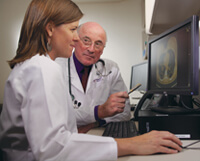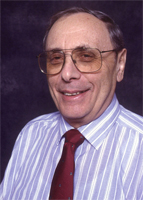National Jewish Health Continues its Unrelenting Effort Here and Abroad
 The Denver TB Course began in 1963 and continues to offer the most comprehensive training in the U.S., for physicians and other healthcare professionals from around the world.
The Denver TB Course began in 1963 and continues to offer the most comprehensive training in the U.S., for physicians and other healthcare professionals from around the world.
Tuberculosis (TB) is embedded in the DNA of National Jewish Health. In 1899, when the disease raged across the nation in epidemic proportions, the National Jewish Hospital for Consumptives opened its doors to care for destitute tuberculosis patients. Throughout the 20th century National Jewish Health contributed research, education and clinical programs that helped bring tuberculosis infections to historically low rates in the United States. Today, tuberculosis remains a global epidemic that infects more than 9 million people each year, and National Jewish Health continues its unrelenting effort here and abroad.
During its first decades National Jewish Health treated thousands of tuberculosis patients from around the nation. It created the first self-contained facility for treating children with TB, established a “preventorium” to prevent TB in children, and launched the nation’s largest and most advanced program for the study and treatment of TB. Its faculty conducted clinical studies crucial to the development of the first effective antibiotics, developed an important culture medium for growth and diagnosis of TB, and defined new diagnostic and treatment protocols still used widely today.
Drug Resistance

 Not long after physicians began using antibiotics, cases of drug-resistant TB began appearing. National Jewish Health became the premier center in the United States for the care of drug-resistant TB, and it still is.
Not long after physicians began using antibiotics, cases of drug-resistant TB began appearing. National Jewish Health became the premier center in the United States for the care of drug-resistant TB, and it still is.
In the 1980s, Leonid Heifets, MD, Director of the Mycobacteriology Laboratory, developed laboratory tests to identify which drugs each strain resisted. Those tests, however, can take three to four weeks to conduct, a period crucial for identifying and beginning effective drug therapy. In the past year, the myocobacteriology laboratory acquired a new instrument that uses genetics to identify drug-resistance patterns within 24 hours.
Education
National Jewish Health faculty have also taught a vast majority of the international TB medical community how to diagnose and treat the disease. Now in its 50th year, the Denver TB course offers the most comprehensive training in the U.S., attended by physicians and other healthcare professionals from around the world.
World-renowned TB and mycobacterial expert Michael Iseman, MD, directed the course for 23 years.
In addition to providing a broad understanding of TB to its participants, the course has played a major role in the dissemination of the practice of Directly Observed Therapy.
TB treatment can last months to years, long after patients begin to feel better. If patients stop taking their medications early, the few remaining TB organisms in their lungs will often repopulate the lungs with drug-resistant organisms.
Directly Observed Therapy relies on public health officials to directly observe patients taking their medications to assure they complete their treatment. Originally formulated by John Sbarbaro, MD, and promoted widely by Dr. Iseman, Directly Observed Therapy has been adopted by the United States and the World Health Organization (WHO).
Recently Dr. Iseman passed leadership of the course to Shannon Kasperbauer, MD. Dr. Kasperbauer first participated in the TB Course as a fellow in 2005.
“I remember how fortunate I felt to be training here where there is such an expertise in TB. I loved the enthusiasm and passion that the speakers had for this topic,” said Dr. Kasperbauer. “I continue to learn from my peers each time I attend the course as director.”
Efforts Across The Globe
Today, the main fronts in the battle against TB are in the developing world. Charles Daley, MD, head of the Division of Mycobacterial and Respiratory Infections, leads our international efforts. In the past year, he and Dr. Kasperbauer helped launch a new TB course in South Africa. Dr. Daley participates in several World Health Organization programs that oversee and advise WHO efforts to more effectively treat and control TB. His research includes a study in Colombia seeking to better diagnose children with TB, and one in Uganda to identify biomarkers to guide treatment.
The Other Mycobacteria
As cases of TB in the U.S. have declined, infections caused by related species of mycobacteria have become more common. Building on its legacy as a leader in research, diagnosis and treatment of tuberculosis, National Jewish Health has evolved into the world’s leading institution for the treatment of these nontuberculous mycobacterial, or NTM, infections. Today, National Jewish Health physicians treat hundreds of NTM infections for every TB case they see.
NTM are widespread in the environment but, unlike TB, cannot be passed from person to person. They commonly cause persistent infections of the lung, but can also infect tissue anywhere in the body. For unknown reasons, they appear to have a predilection for slender, Caucasian women. NTM are hardy organisms, and people who suffer lung infections may require extensive antibiotic treatments off and on for the rest of their lives.
Thanks to a grant from the Amon G. Carter Foundation, National Jewish Health has launched a collaborative effort of the Advanced Diagnostics Laboratory, the Mycobacteriology Laboratory, the Center for Genes, Environment and Health, and the Division of Mycobacterial and Respiratory Infections to better understand and diagnose the disease. In the past year, the interdisciplinary team has developed new diagnostic tests, discovered a new NTM species, and begun sequencing the organisms’ genomes.
 Clinical Trials
Clinical Trials

 The Denver TB Course began in 1963 and continues to offer the most comprehensive training in the U.S., for physicians and other healthcare professionals from around the world.
The Denver TB Course began in 1963 and continues to offer the most comprehensive training in the U.S., for physicians and other healthcare professionals from around the world.
 Not long after physicians began using antibiotics, cases of drug-resistant TB began appearing. National Jewish Health became the premier center in the United States for the care of drug-resistant TB, and it still is.
Not long after physicians began using antibiotics, cases of drug-resistant TB began appearing. National Jewish Health became the premier center in the United States for the care of drug-resistant TB, and it still is.